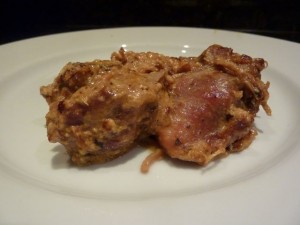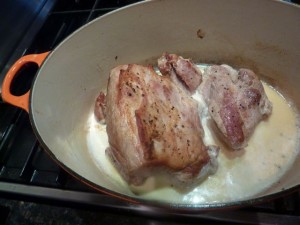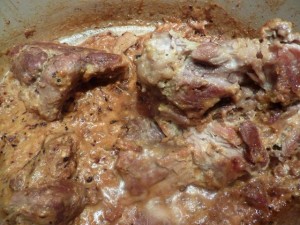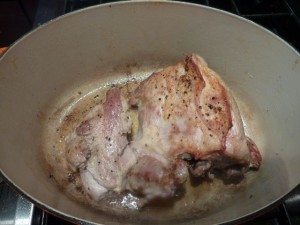
The first time I cooked this dish, the decision was born out of desperation. During the winter months, I live at Sugarloaf, ME, and the nearest somewhat reasonable grocer is fifteen miles away. My refrigerator was pretty bare, and I was looking through my various recipe books for something that required ingredients I already had on hand. This was perfect – all I needed was pork, butter, olive oil, and milk.
But I return to this recipe again and again, even when my pantry isn’t quite so barren. It’s wonderfully tasty, as well as wonderfully simple. The slow cooking transforms even the toughest cuts of pork into tender chunks of flavor that only requires a fork to eat; the milk becomes nutty, brown clusters that make a delicious sauce, albeit one that is not particularly visually attractive. However, if that bothers you, a quick dip with an immersion blender can fix that.

There are many versions of this recipe, and many regions of Italy which claim it as a traditional food. Marcella Hazan, in her classic book “Essentials of Italian Cooking”, includes a recipe for pork loin braised in milk, which she identifies as “Bolognese Style”. I have also seen other versions, some that braise the pork in milk, some that roast it in the oven. All types of cuts are used, from pork chops to roasts to loins to shoulders/butts. Some claim the recipe is Tuscan, others identify it as a classic food in the Veneto, still others in Friuli-Venezia Giulia. It probably hails from all of these regions, any that raised both pigs and cows.
My fellow food blogger and a guest on one of our Italiaoutdoors tours, Steve Dunn from Oui, Chef did a great job covering this same dish a while ago on his blog – check out his version of Maiale al Latte. He adds a few more flavoring ingredients, sage leaves, garlic and lemon zest. I always encourage my cooking students to add their own creativity to what they prepare, so play with different herbs (bay), or try the addition of some white wine, which I also saw in some recipes. This is the ‘austere’ version, but you will be surprised at how much flavor the cooking process alone brings to this dish.

One interesting note I learned while reading up on this dish – the Italian word for pork, maiale, comes from the Roman goddess Maia, mother of Mercury. The Romans used to sacrifice pigs to earn her good graces. You will usually see the cut of meat (arrosto, braciole) included in the name of this dish; maiale al latte in Italian can also refer to suckling pig.
After researching several recipe variations, I decided to base my dish on Marcella Hazan’s. Many of the recipes add all the milk at the beginning; Marcella recommends adding the milk 1 cup at a time, allowing it to cook down and brown before adding more. I also recommend the pork shoulder or Boston butt for this recipe, which will take a while to cook, but the result will be worth the wait. The tenderloins we find today have been bred to make them as lean as possible, the upshot of this can be a rather dry dish at the end of an extended cooking time. The higher fat content of these cheaper cuts avoids this problem.
Brasato di Maiale al Latte (Braised Pork in Milk)
1 pork shoulder or boston butt, about 4-5 lbs.
Kosher salt and freshly ground pepper
2 tablespoons butter
2 tablespoons pure olive oil
3 cups, or more, whole milk
Place the pork on a sheet pan, and season on all sides with salt and pepper.

In a heavy-bottomed pot, such as a La Creuset enamel pot, place the butter and olive oil and heat over medium-high heat. When the foam subsides, add the pork and sear until it is browned on all sides. If the butter begins to turn a bit too brown, reduce the heat.
When the meat is browned, very carefully and slowly add 1 cup of the milk. It can boil over quite quickly. Allow the milk to come to a simmer, then reduce the heat as low as you possibly can, place the lid on the pot slightly ajar, and let cook at the lowest simmer for about one hour, checking after about 40 minutes or so.
After 45 minutes to 1 hour, the milk should be thickened and fairly dark brown in color. Turn the pork, and add another cup of milk. Bring to a simmer, then reduce the heat, again place the lid on, tightly this time, and allow to cook for another hour.
Again, repeat the process. After the hour, the milk should be no longer be ‘liquid’, but thickened nut-brown clusters. Turn the pork, add the last cup of milk, cover and cook for another hour.
Check the pork for tenderness – you want the meat to fall apart easily when prodded a bit with a fork. If it is still fairly tough, add more milk and continue to cook.
When the pork is tender, and all the milk in the pot has thickened into nut-brown clumps, remove the pork to a cutting board and allow to sit for a few minutes. Scrape the bottom and sides of the pot to loosen any bits of sauce that are stuck. If there are some nicely browned bits on the bottom that aren’t coming off, add a bit more milk or water, and reduce while you scrape them off. If you wish to make the sauce a bit more elegant in appearance, you can add in a bit of heavy cream and give it a quick mix with an immersion blender.
Serve, topping the meat with a bit of the sauce.
